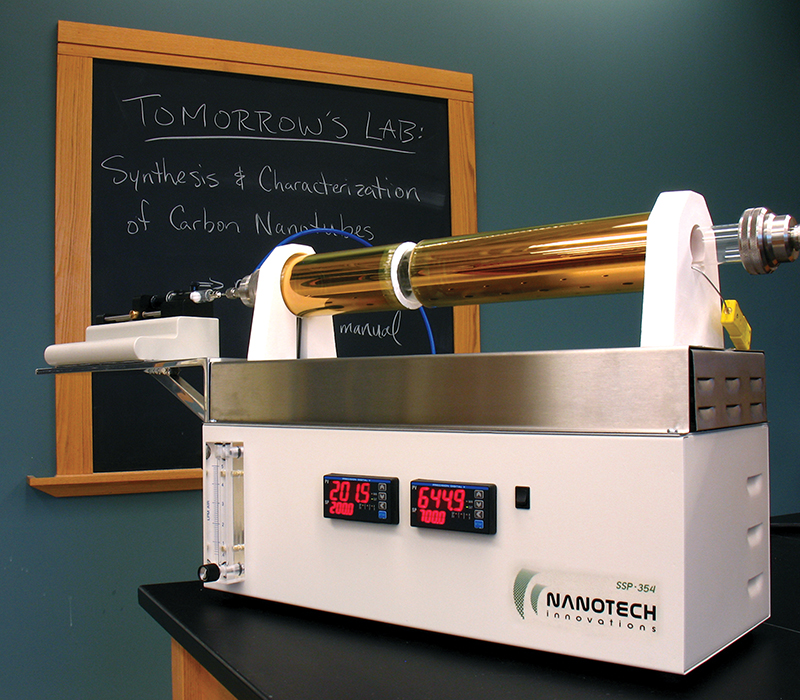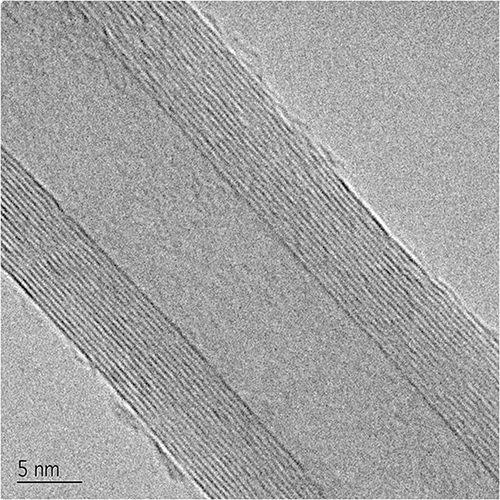
Nanotube Production Devices Expand Research Capabilities
NASA Technology
In order for the Hubble Space Telescope to take incredible, never-seen-before shots of celestial bodies and then send them back to Earth, the spacecraft needs power. While in orbit, Hubble cannot plug into an electrical outlet or stop at a store for some batteries. One of the ways NASA supplies power aboard a spacecraft is by harnessing energy from the most powerful entity in the solar system: the Sun. Since the 1960s, photovoltaic technology, or technology that converts sunlight into electricity, has been instrumental in the exploration of space.
To build upon existing photovoltaic technology, NASA’s Glenn Research Center has worked on a variety of innovative designs and materials to incorporate into photovoltaic cells, the building blocks of solar power systems. One of these materials is the carbon nanotube—a tiny structure about 50,000 times finer than the average human hair, with notably high electrical and thermal conductivity and an extreme amount of mechanical strength. Such properties give carbon nanotubes great potential to enhance the reliability of power generation and storage devices in space and on Earth.
Dennis J. Flood, the branch chief of the photovoltaic division at Glenn in the 1990s, was looking into using carbon nanotubes to improve the efficiency of solar cells when he ran into a major roadblock—high-quality carbon nanotubes were not readily available. To address this problem, one of the chemists in Flood’s group came up with a process and system for growing them.
A senior chemist at Glenn, Aloysius F. Hepp, devised an injection chemical vapor deposition process using a specific organometallic catalyst in a two-zone furnace. Hepp’s group found the unique process produced high-quality carbon nanotubes with less than 5 percent metal impurity. In addition, the process was more efficient than existing techniques, as it eliminated pre-patterning of the substrate used for growing the nanotubes, a timely and cost-prohibitive step.
Partnership
Because Glenn was more interested in the photovoltaic technology that could benefit from the incorporation of carbon nanotubes, and not in the actual production of the carbon nanotubes themselves, the Center released the technology to the inventors—Hepp and fellow researcher Jerry Harris, associate professor of chemistry at Northwest Nazarene University—in 2005. By that time, Flood had retired from NASA, and he and his son, Dennis M. Flood, founded Nanotech Innovations in Oberlin, Ohio. They filed a full patent application, and in 2010, Nanotech Innovations was awarded a patent for the process and apparatus to grow high-quality, low-impurity carbon nanotubes.
Benefits
For several years, the company has focused on improvement. Now a portable, bench-top system, the technology can make research-scale quantities of high-quality nanotubes within just a few hours. Called the SSP-354, one of the major advantages of the NASA-derived technology is that it is a single-step process. Most processes for growing carbon nanotubes require at least a two-step process, explains the younger Flood, but the SSP-354 does not require catalyst pre-deposition or expensive substrate preparation. The user simply loads the injector and presses “Start.”
According to Nanotech Innovations, the carbon nanotubes produced by the system have low catalyst content (a low amount of impurity), which has been demonstrated by tests and analysis techniques including thermogravimetric analysis, Raman spectrometry, and electron microscopy. An additional advantage is that the technology allows full control of the growth parameters for the desired nanotubes.
Today, the machine is supporting the incorporation of carbon nanotubes into science curricula, research, and product development endeavors. Rice University purchased the SSP-354, and according to Andrew R. Barron, a professor of materials science at Rice, “This instrument adds fabrication of high-quality, multi-walled carbon nanotubes to our repertoire in a simple-to-use-system that even first-year undergraduate students can use.”
North Dakota State’s College of Science also purchased the technology and is integrating it into their nanoscience curriculum. The Akron University Polymer Science Department purchased the SSP-354 for its laboratory and finds the system has become an integral part of its research and development efforts.
“With so many next-generation devices looking to use carbon nanotubes, there’s going to be a big push for lab technicians and other people who are familiar with the synthesis, handling, and applications of carbon nanotubes,” says Flood. “There’s going to be an influx of people that need to be trained in nanotechnology, and carbon nanotubes in particular. We are starting to help to develop a curriculum that can train the next generation of lab technicians.”
At the Ohio State University’s Wright Center for Photovoltaic Innovation and Commercialization, the SSP-354 gives member companies a solution for obtaining high-quality carbon nanotubes for their research and product development. “The ease of use and repeatability of results makes it an ideal instrument for anyone using carbon nanotubes in their work,” says Oleg Kuznetsov, a research scientist with member company Natcore Technology Inc.
Most recently, Nanotech Innovations announced that it signed Nanoscience Instruments Inc. to be the exclusive distributor of the SSP-354 in the United States. The company also announced a new partnership with Strem Chemicals Inc. to sell nanotube arrays produced with the SSP-354.
Flood says NASA played a large part in the success of Nanotech Innovations. “The fact that the genesis of this technology is a NASA technology has helped us and continues to help us,” says Flood. “Now we are the owners, but I think NASA adds a lot of credibility to what we are and what we have.
research, and product development endeavors.

This transmission electron microscope high-resolution image shows aligned, high-quality, low-impurity carbon nanotubes grown by a novel process and system invented at Glenn Research Center.

The NASA-derived system from Nanotech Innovations makes carbon nanotubes for science curricula, research, and product development. Carbon nanotubes show great promise for applications such as power devices, sensors, and drug delivery systems.













